#vedic culture
Explore tagged Tumblr posts
Text
About Vedic Scriptures
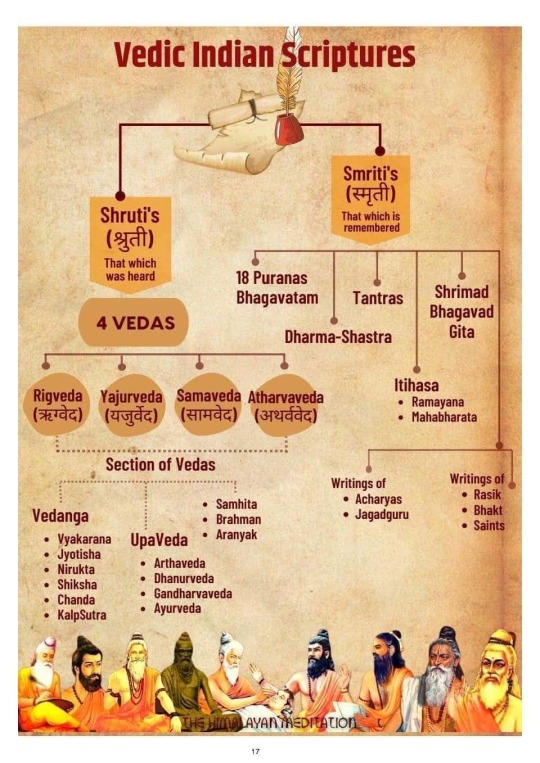


#vedic literature#hinduism#hindublr#sanatan dharma#ancient india#vedic culture#mantra#bharat#ancient indian history#puranas#sanskrit#languages#krishna#dharma#karma#hindu culture
314 notes
·
View notes
Text
What is Badhaka planet in Vedic astrology? What is its significance?
In Vedic astrology, the term Badhaka (literally meaning "obstacle" or "hindrance") refers to a specific planet that acts as a potential troublemaker or obstructive force in a person's life, depending on the ascendant (Lagna). The concept of the Badhaka planet is primarily related to the principles of Jaimini astrology, and it holds significance for understanding challenges or delays in achieving specific goals.
How Is the Badhaka Planet Determined?
The Badhaka planet is identified based on the ascendant (Lagna) and the classification of houses in a chart:
For Movable Signs (Chara Rashis): Aries, Cancer, Libra, Capricorn
The 11th house lord is the Badhaka planet.
Example: For Aries Lagna, Aquarius is the 11th house, so Saturn becomes the Badhaka planet.
For Fixed Signs (Sthira Rashis): Taurus, Leo, Scorpio, Aquarius
The 9th house lord is the Badhaka planet.
Example: For Taurus Lagna, Capricorn is the 9th house, so Saturn becomes the Badhaka planet.
For Dual Signs (Dwiswabhava Rashis): Gemini, Virgo, Sagittarius, Pisces
The 7th house lord is the Badhaka planet.
Example: For Gemini Lagna, Sagittarius is the 7th house, so Jupiter becomes the Badhaka planet.
What Does the Badhaka Planet Represent?
The Badhaka planet is considered a source of obstacles, delays, or hindrances in life. Its placement and influence in the natal chart can create challenges in the areas of life it governs. However, it doesn’t always act negatively; under certain conditions, it can lead to growth through challenges or be neutralized by benefic influences.
Obstructions and Delays:
The Badhaka planet might cause delays in achieving success, fulfilling desires, or attaining goals.
Health Issues:
If the Badhaka planet is associated with the 6th, 8th, or 12th houses, it may bring health problems or accidents.
Relationship Challenges:
When linked to the 7th house, the Badhaka planet can cause relationship struggles, misunderstandings, or delayed marriages.
Spiritual Growth:
Obstacles caused by the Badhaka planet often lead to introspection and spiritual development.
Karmic Lessons:
It is often seen as a trigger for karmic lessons that one must face and overcome.
Factors That Modify Its Influence
Benefic Influence:
If the Badhaka planet is aspected by or in conjunction with benefic planets like Jupiter or Venus, its negative effects may reduce significantly.
House Placement:
The Badhaka planet’s influence depends on which house it occupies:
In the 1st, 4th, 7th, or 10th houses, it might create visible struggles.
In the 6th, 8th, or 12th houses, hidden challenges or health issues might arise.
Dasha Periods:
The effects of the Badhaka planet are particularly noticeable during its dasha (planetary period) or antardasha (sub-period).
Strength and Dignity:
If the Badhaka planet is exalted or in its own sign, its negative effects may reduce, and it can act as a source of constructive challenges.
Remedies for Badhaka Planet
Mantras:
Chant mantras associated with the Badhaka planet or its ruling deity.
Example: For Saturn as the Badhaka planet, chant the Shani mantra or the Hanuman Chalisa.
Charity and Donations:
Donate items related to the Badhaka planet on its specific day.
Example: Donate black sesame seeds, iron, or black cloth for Saturn.
Strengthening Lagna Lord:
Strengthening the ascendant lord can reduce the negative impact of the Badhaka planet.
Worship:
Offer prayers to deities associated with the planet. For example:
Worship Lord Shiva for Saturn.
Worship Lord Vishnu for Jupiter.
Gemstones:
Wear gemstones only after consulting a qualified astrologer, as strengthening a Badhaka planet may not always be advisable.
Key Points to Remember
The Badhaka planet does not always bring negative results. Its influence can lead to growth and transformation if handled correctly.
Its effects depend on the overall chart, including aspects, conjunctions, and yogas involving the Badhaka planet.
Challenges caused by the Badhaka planet are meant to teach lessons and lead to spiritual evolution.
By understanding and addressing the Badhaka planet’s influence in the horoscope, one can navigate its challenges effectively and transform obstacles into opportunities for growth.
#astrology#astro#astro planets#astro observations#vedic culture#vedic astrology#Vedic#vedic astro notes#vedic mantra#vedic astro observations#vedic chart
50 notes
·
View notes
Text
Continuing the legacy of the Rigvedic priests and spreading my Indraite propaganda with @inc0rrectmyths and @hydestudixs
Art credits: Vimanika Arts, David Benzal, Bhairav Pujari (and idk the rest so if any of you know pls lmk)
#hindu mythology#hindu gods#hindu deities#hindu myths#rig veda#vedic mythology#vedic culture#hinduism#reels#instagram reels#hindublr#desiblr#desi tumblr#desi tag#desiposting#indra#hindu god#hindu
64 notes
·
View notes
Text
I like the fact that how Lord Vishnu is portrayed like this calm CEO who speaks in a soothing tone and has everything planned and handled but some of His Avatars:
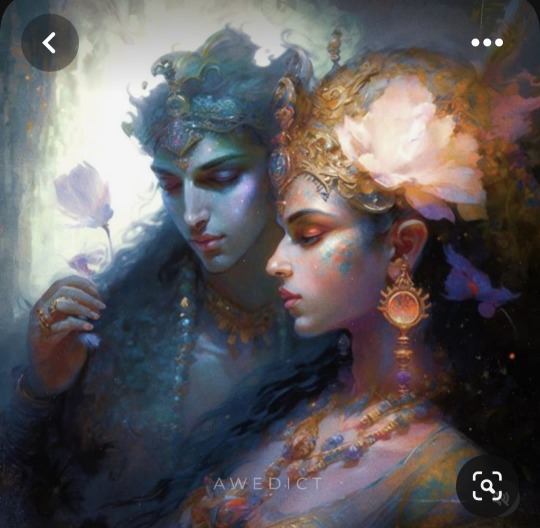
1. VARAHA DEVA:Speared Hiranyaksha with His tusks
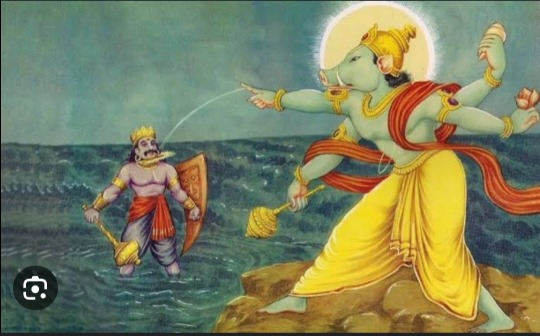
2. NARASIMHA DEVA: Ripped apart Hiranyakashipu ,drank his blood and garlanded Himself with his intestines

3. PARASHURAMA DEVA: Killed the entire Kshatriya clan 21 times before retirement

4. KRISHNA: Kanha is well... Kanha

In my humble and unqualified opinion , the closest any Avatara of Lord Vishnu to His Bhujangashayana form is Lord Rama. Calm and serene. I can sit at His feet for hours and look at His face.

Tagging:@nirmohi-premika @jukti-torko-golpo @krishnapriyakiduniya @krishna-sahacharini @krishna-priyatama @shyamsakhii @sanskari-kanya @shut-up-rabert @budugaapologist @witchconnectingdotes @janaknandini-singh999 @themorguepoet @harinishivaa @suvarnarekha @softbeanofexistentialcrisis
#desiblr#krishna#hinduism#desi culture#vedic culture#vishnu#lord vishnu#lord krishna#lord rama#rama#Parashuram#narasimha#varaha#hindu#hinduism aesthetics#sanatan dharma#vedic
672 notes
·
View notes
Text
Astro Tip of the day:

𝐋𝐨𝐨𝐤 𝐚𝐭 𝐲𝐨𝐮𝐫 𝐍𝐚𝐤𝐬𝐡𝐚𝐭𝐫𝐚 𝐏𝐥𝐚𝐧𝐞𝐭 𝐑𝐮𝐥𝐞𝐫, 𝐚𝐧𝐝 𝐭𝐡𝐞 𝐍𝐚𝐤𝐬𝐡𝐚𝐭𝐫𝐚 𝐰𝐡𝐢𝐜𝐡 𝐭𝐡𝐚𝐭 𝐩𝐥𝐚𝐧𝐞𝐭 𝐬𝐢𝐭𝐬 𝐢𝐧. 𝐓𝐡𝐢𝐬 𝐜𝐚𝐧 𝐠𝐢𝐯𝐞 𝐦𝐨𝐫𝐞 𝐢𝐧𝐬𝐢𝐠𝐡𝐭 𝐫𝐞𝐠𝐚𝐫𝐝𝐢𝐧𝐠 𝐲𝐨𝐮𝐫 𝐩𝐞𝐫𝐬𝐨𝐧𝐚𝐥𝐢𝐭𝐲, 𝐚𝐧𝐝 𝐩𝐞𝐫𝐬𝐨𝐧𝐚𝐥 𝐢𝐧𝐭𝐞𝐫𝐞𝐬𝐭𝐬. 𝐓𝐡𝐢𝐬 𝐢𝐬 𝐣𝐮𝐬𝐭 𝐚𝐧𝐨𝐭𝐡𝐞𝐫 𝐥𝐚𝐲𝐞𝐫 𝐨𝐟 𝐲𝐨𝐮𝐫 𝐚𝐬𝐜𝐞𝐧𝐝𝐚𝐧𝐭, 𝐚𝐧𝐝 𝐞𝐱𝐩𝐥𝐚𝐢𝐧𝐬 𝐰𝐡𝐲 𝐬𝐨𝐦𝐞 𝐨𝐟 𝐮𝐬 𝐜𝐚𝐧 𝐡𝐚𝐯𝐞 𝐭𝐡𝐞 𝐬𝐚𝐦𝐞 𝐚𝐬𝐜𝐞𝐧𝐝𝐚𝐧𝐭 𝐛𝐮𝐭 𝐚𝐜𝐭 𝐬𝐥𝐢𝐠𝐡𝐭𝐥𝐲 𝐝𝐢𝐟𝐟𝐞𝐫𝐞𝐧𝐭 𝐚𝐧𝐝 𝐡𝐚𝐯𝐞 𝐝𝐢𝐟𝐟𝐞𝐫𝐞𝐧𝐭 𝐢𝐧𝐭𝐞𝐫𝐞𝐬𝐭𝐬!





𝐅𝐨𝐫 𝐄𝐱𝐚𝐦𝐩𝐥𝐞, 𝐋𝐞𝐭'𝐬 𝐬𝐚𝐲 𝐬𝐨𝐦𝐞𝐨𝐧𝐞 𝐰𝐚𝐬 𝐚𝐧 𝐃𝐡𝐚𝐧𝐢𝐬𝐭𝐚 𝐀𝐬𝐜. 𝐓𝐡𝐞 𝐫𝐮𝐥𝐞𝐫 𝐨𝐟 𝐭𝐡𝐢𝐬 𝐧𝐚𝐤 𝐰𝐨𝐮𝐥𝐝 𝐛𝐞 𝐌𝐚𝐫𝐬. 𝐓𝐡𝐢𝐬 𝐩𝐞𝐫𝐬𝐨𝐧'𝐬 𝐌𝐚𝐫𝐬 𝐬𝐢𝐭𝐬 𝐢𝐧 𝐒𝐡𝐚𝐭𝐚𝐛𝐡𝐢𝐬𝐡𝐚. 𝐓𝐡𝐢𝐬 𝐬𝐡𝐨𝐰𝐬 𝐭𝐡𝐚𝐭 𝐭𝐡𝐞𝐲 𝐚𝐫𝐞 𝐡𝐞𝐚𝐯𝐢𝐥𝐲 𝐢𝐧𝐟𝐥𝐮𝐞𝐧𝐜𝐞𝐝 𝐛𝐲 𝐬𝐚𝐭𝐮𝐫𝐧𝐢𝐚𝐧 & 𝐚𝐪𝐚𝐮𝐫𝐢𝐮𝐚𝐧 𝐞𝐧𝐞𝐫𝐠𝐲. 𝐓𝐡𝐢𝐬 𝐩𝐞𝐫𝐬𝐨𝐧 𝐰𝐢𝐥𝐥 𝐛𝐞𝐧𝐞𝐟𝐢𝐭 𝐟𝐫𝐨𝐦 𝐝𝐨𝐢𝐧𝐠 𝐭𝐡𝐢𝐧𝐠𝐬 𝐜𝐨𝐧𝐜𝐞𝐫𝐧𝐢𝐧𝐠 𝐭𝐞𝐜𝐡𝐧𝐨𝐥𝐨𝐠𝐲, 𝐚𝐧𝐝 𝐮𝐬𝐢𝐧𝐠 𝐭𝐡𝐞𝐢𝐫 𝐇𝐢𝐠𝐡𝐞𝐫 𝐌𝐢𝐧𝐝 𝐭𝐨 𝐠𝐞𝐭 𝐚𝐡𝐞𝐚𝐝. 𝐒𝐢𝐧𝐜𝐞 𝐭𝐡𝐢𝐬 𝐢𝐬 𝐭𝐡𝐞 𝐩𝐥𝐚𝐧𝐞𝐭 𝐨𝐟 𝐦𝐚𝐫𝐬, 𝐭𝐡𝐞𝐢𝐫 𝐬𝐭𝐫𝐞𝐧𝐠𝐭𝐡 𝐢𝐬 𝐭𝐡𝐞𝐢𝐫 𝐬𝐦𝐚𝐫𝐭𝐬. 𝐓𝐡𝐢𝐬 𝐜𝐚𝐧 𝐚𝐥𝐬𝐨 𝐢𝐧𝐝𝐢𝐜𝐚𝐭𝐞 𝐭𝐡𝐚𝐭 𝐭𝐡𝐞𝐲 𝐚𝐫𝐞 𝐡𝐢𝐠𝐡𝐥𝐲 𝐢𝐧𝐭𝐮𝐢𝐭𝐢𝐯𝐞 𝐚𝐧𝐝 𝐡𝐚𝐯𝐞 𝐚𝐧 𝐚𝐛𝐮𝐧𝐝𝐚𝐧𝐜𝐞 𝐨𝐟 𝐡𝐞𝐚𝐥𝐢𝐧𝐠 𝐞𝐧𝐞𝐫𝐠𝐲. 𝐓𝐡𝐞𝐢𝐫 𝐠𝐢𝐟𝐭 𝐢𝐬 𝐚𝐜𝐜𝐮𝐦𝐮𝐥𝐚𝐭𝐢𝐧�� 𝐤𝐧𝐨𝐰𝐥𝐞𝐝𝐠𝐞. 𝐌𝐨𝐬𝐭 𝐥𝐢𝐤𝐞𝐥𝐲 𝐭𝐨 𝐡𝐚𝐯𝐞 𝐯𝐞𝐫𝐲 𝐬𝐭𝐫𝐨𝐧𝐠 𝐞𝐧𝐞𝐫𝐠𝐲 𝐚𝐬 𝐰𝐞𝐥𝐥. 𝐓𝐡𝐢𝐬 𝐧𝐚𝐭𝐢𝐯𝐞 𝐡𝐚𝐬 𝐮𝐧𝐜𝐨𝐧𝐯𝐞𝐧𝐭𝐢𝐨𝐧𝐚𝐥 𝐞𝐱𝐩𝐞𝐫𝐢𝐞𝐧𝐜𝐞𝐬 𝐢𝐧 𝐥𝐢𝐟𝐞, 𝐚𝐧𝐝 𝐚 𝐮𝐧𝐜𝐨𝐧𝐯𝐞𝐧𝐭𝐢𝐨𝐧𝐚𝐥 𝐰𝐚𝐲 𝐨𝐟 𝐭𝐡𝐢𝐧𝐤𝐢𝐧𝐠.
𝐌𝐲 𝐀𝐬𝐜 𝐢𝐬 𝐏𝐮𝐧𝐚𝐫𝐯𝐚𝐬𝐮 𝐰𝐡𝐢𝐜𝐡 𝐢𝐬 𝐫𝐮𝐥𝐞𝐝 𝐛𝐲 𝐉𝐮𝐩𝐢𝐭𝐞𝐫, 𝐌𝐲 𝐉𝐮𝐩𝐢𝐭𝐞𝐫 𝐬𝐢𝐭𝐬 𝐢𝐧 𝐏𝐮𝐫𝐯𝐚 𝐏𝐡𝐚𝐥𝐠𝐮𝐧𝐢. 𝐈 𝐫𝐞𝐬𝐨𝐧𝐚𝐭𝐞 𝐚𝐥𝐨𝐭 𝐰𝐢𝐭𝐡 𝐭𝐡𝐞 𝐞𝐧𝐞𝐫𝐠𝐲 𝐨𝐟 𝐩𝐮𝐫𝐯𝐚 𝐩𝐡𝐚𝐥𝐠𝐮𝐧𝐢. 𝐓𝐡𝐢𝐬 𝐧𝐚𝐤 𝐫𝐞𝐩𝐫𝐞𝐬𝐞𝐧𝐭𝐬 𝐬𝐞𝐧𝐬𝐮𝐚𝐥𝐢𝐭𝐲, 𝐚𝐫𝐭𝐬, 𝐦𝐮𝐬𝐢𝐜, 𝐚𝐧𝐝 𝐩𝐥𝐞𝐚𝐬𝐮𝐫𝐞 𝐚𝐬 𝐢𝐭𝐬 𝐫𝐮𝐥𝐞𝐝 𝐛𝐲 𝐯𝐞𝐧𝐮𝐬. 𝐓𝐡𝐞𝐬𝐞 𝐚𝐫𝐞 𝐭𝐡𝐢𝐧𝐠𝐬 𝐭𝐡𝐚𝐭 𝐝𝐨 𝐢𝐧𝐭𝐞𝐫𝐞𝐬𝐭 𝐦𝐞, 𝐚𝐧𝐝 𝐈 𝐧𝐨𝐭𝐢𝐜𝐞𝐝 𝐈 𝐩𝐮𝐭 𝐚 𝐥𝐨𝐭 𝐨𝐟 𝐭𝐢𝐦𝐞 𝐢𝐧𝐭𝐨 𝐚𝐧𝐝 𝐚𝐥𝐬𝐨 𝐬𝐩𝐞𝐧𝐝 𝐚 𝐥𝐨𝐭 𝐨𝐟 𝐦𝐨𝐧𝐞𝐲 𝐨𝐧. 𝐀𝐞𝐬𝐭𝐡𝐞𝐭𝐢𝐜𝐬, 𝐟𝐚𝐬𝐡𝐢𝐨𝐧, 𝐚𝐧𝐝 𝐦𝐮𝐬𝐢𝐜 𝐚𝐫𝐞 𝐚𝐥𝐥 𝐭𝐡𝐢𝐧𝐠𝐬 𝐭𝐡𝐚𝐭 𝐛𝐫𝐢𝐧𝐠 𝐦𝐞 𝐣𝐨𝐲. (𝐉𝐮𝐩𝐢𝐭𝐞𝐫 𝐢𝐧 𝟐𝐇 🤭)

©𝓟𝓻𝓮𝓽𝓽𝔂 𝓒𝓪𝓻𝓪𝓶𝓮𝓵 2023
#astro community#pretty caramel#astrology posts#astro notes#astro observations#astro posts#natal chart#astro placements#vedic astro notes#vedic astrology#vedic astro observations#vedic chart#vedic culture#astrology birth chart#nakshatras#shatabhisha#punarvasu
237 notes
·
View notes
Text

Vedic Temples 'वैदिक मंदिर' ॐ
Attractive sculpture of Arunachaleswarar Temple, Tiruvannamalai, Tamilnadu, Bharat (India) The present masonry structure was built during the Chola dynasty in the 9th century. #Hinduism
32 notes
·
View notes
Text
🤍 Venus - The essence of beauty.
शुक्र - Shukra is known as Venus .
In Sanskrit , Shukra (Venus) means clear or bright. He is also known as the Guru of the the Daityas - the powerful but demonic beings. ( In whom ignorance , selfishness, dullness , greed is more high ) . These are the most difficult students & difficult lessons to learn . And these are also the traits that are also within us that lead us away from our true self .
There's deeper meaning to it .
Venus signifies beauty , material wealth , sensuality, Art , love , sex , creativity, relationships, great depth of understanding , soft & tender feelings , comforts , addictions , and most importantly spiritual wealth too.
On a superficial level Venus grants outward beauty , good relationships , love , sex , material wealth & possessions but on a deeper level , Venus is clarity & illumination . It represents the true essence of beauty which can only be felt within , the clarity we attain after realising our true self , the love we discover for our all parts of personality - the soft tender & the rough rejected dark edges . Understanding our selves and thus the compassion we feel for ourselves , the brightness of our hearts .
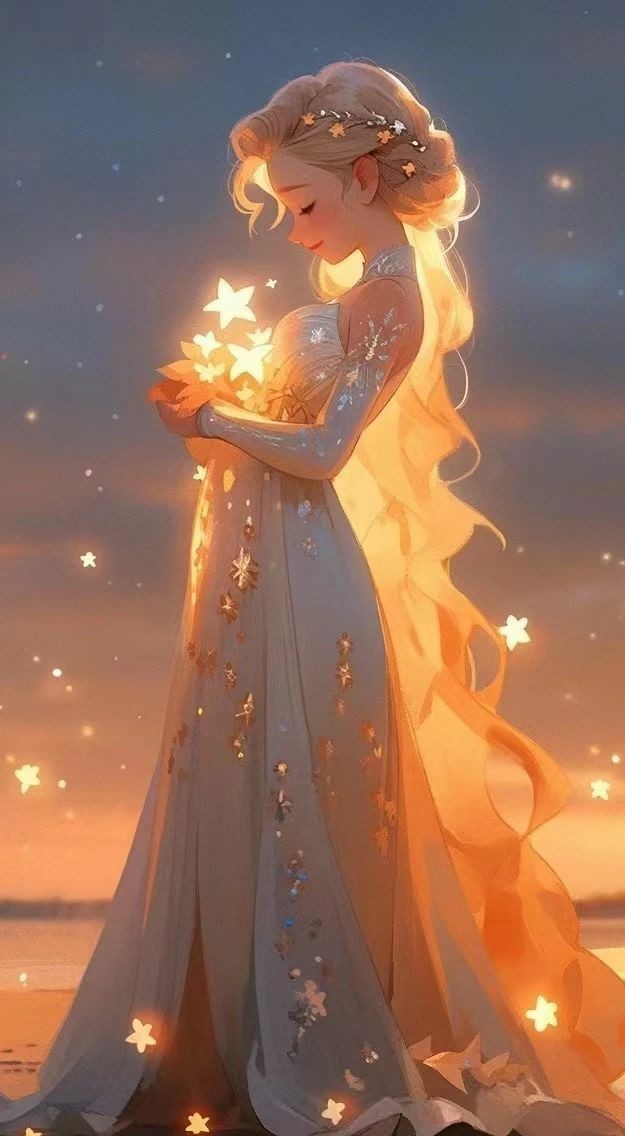
Venus also represents our relationships. How our relationship is with our inner world reflects in our outer relationships & world as well. 💌
🤍 When we establish and honor our need for quality time for solitude , we are able to connect with something permanent within. The silence & the depth of stillness. And in that stillness , true love blossoms . This love encompasses not only ourself but all others.
☘️ It's significations - singing , painting, literature , dance etc carry the song of the soul . It's for its own sake. The blossoming happens within & the fragrance shares itself & thus attracts. 🪷💚
🌻Sex is another way to transcend the boundaries of our timid self and experience that unification with everything & nothing .

🤍 Venus also teaches us that lower levels of addiction are in itself just inadequate ways to obtain that true understanding and love . It's the teaching as well as a lesson. You can get lost in the Mirage of Maya ( Illusion) that Venus creates or you can see through it and realise what really matters. The truest , most intimate love relationship you will ever have is with yourself first.
🤍 In solitude , silence , stillness & with proper guidance , in the environment of pisces , Venus finally gets to emit it's true brilliance. It's true face.
🪷The understanding that the other is the self too.
🪷That there's only oneness. Letting go of our boundaries & merging.
🪷That You and I are one on the deepest Level. That god is everything & nothing . And this is the reason why Venus is exalted in pisces in the sweet tender creative nurturing last Nakshatra of the karmic zodiac cycle - Revati. 🤍 Total dissolution , transcendence & Realisation of self.

💌Life itself is art & thus living intensely & fully in the moment . The beauty , terror & the adventure . Venus teaches us the tantrik way of living . Immersion and witnessing .💌 Simultaneously.

#astro observations#astrology#astrology observations#counseling#vedic#vedic astro notes#vedic astro observations#astro notes#astrology blog#astrologer#pisces#vedic culture#venus#exalted#planets#synastry#love#self love#beauty
121 notes
·
View notes
Text
Doshas in Ayurveda🪸

🪷'dosha' in sanskrit means fault or weakness. it is used in ayurveda to find the weakness in nature of people.
🪷a dosha can become your strength and also has the ability to become your weakness.
vata— air quality 🌪
pitta— fire quality 🔥
kapha— water quality 💧
🪷these doshas are responsible for a person’s physiological, mental, and emotional health.
here's what they denote-
❖ VATA
perception, action, enthusiasm, creativity, communication, inspiration
❖ PITTA
it produces heat and controls the digestive system. hunger, thirst, competitiveness, leadership, cheerfulness, intelligence, ambition, vision, biliousness
❖ KAPHA
phlegmatic, stability of the body, calmness, suppleness of joints, strong bones, potency, strength, caring
#dosha#doshas#doshas in ayurveda#ayurveda#vedic notes#astro community#astrology community#astrology#pitta dosha#vata dosha#kapha dosha#vedas#vedic culture#vedic astrology
68 notes
·
View notes
Text
Symbol of Ardra Nakshatra ( 6°40′ to 20°00′ Gemini): Raindrops, Teardrops, Storm, A human head & Diamond




a storm : dangerous and destructive side of mother nature but at the same time storms act as natural cooling systems of this planet, through lightning it create more ozone, bring rain to the areas where it was much needed, replenish the underground water. Deity of this Nakshatra is Rudra, the god of storm. Rudra & his female counterpart Rudrani were born when Brahma became extremely frustrated with creating beings to populate this universe. Similar to the storm, Rudra & his offspring were fiery, destructive, angry, dangerous, howling. Ardra signifies the frustration that creativity brings ,shows us the things that we have to overcome before we are able to create what we desire. Just like the storm, it represents the need for destruction, importance of rest, starting with a clean slate, forgetting & letting go, discarding things do not serve us anymore. It reminds us that creation & destruction go hand in hand and they both need each other. Anger and destruction also serve a purpose.
Teardrops cleanse our pent up emotions & grief like raindrops replenish nature. Additionally it symbolizes the source of all sorrow, sadness & grief.
Diamond shows their strong determination & brilliance
Ardra is also represented by a human head ( Brahma's 5th head ) which symbolizes ego, arrogance, lust.
#astrology#gemini#vedic culture#vedic astrology#vedic astro notes#vedic literature#astro notes#astrology observations#sidereal astrology#astro observations#vedic astro observations#sidereal chart#air signs#sidereal zodiac#nakshatras
142 notes
·
View notes
Text
Random art/history/spirituality/pop culture thread.
Finished a rewatch recently of A:TLA and Korra as well.
Avatar itself is a South Asian concept that in Sanskrit means Descent, as in descended from - signifying the incarnation/material appearance of a powerful deity or spirit.
Aang and Korra are literally that - the new incarnations of a long tradition of the Avatar being reborn to save/aid/guide a world.
The concept under the name, Avatar, didn't exist in Vedic literature, though, but post-Vedic (again by name, reincarnation and the meaning/point/mythic use did exist, as did a doctrine about the idea of avatars, but again, not the term used as such in some of the original texts).
Instead, terms like "from/of divine descent" - 19th century rising Western interest in Hinduism at the time led to Avatar being yoinked as a loanword to English. But what else?
Well, specifically in the rewatch, something I thought was rather sweet: The mention of Guru Laghima.
This happens in Korra where one of the villains (I shouldn't say no spoilers so far long after the show's ended but...polite?) when a big villain reveals their interest in the writings of this Guru and...it leads to this villain being able to fly.
Well, let's look into Laghima.
Now, there was no Guru Laghima in real life, obviously. But the last name here? It's really a word -- a concept.
Oooooo. A reference.
So, what is Laghima?
In a nutshell. "Lightness." It is "The Absence of Weight."
It is one of the 8 major Siddhis - the spiritual or supernatural abilities achieved by those who've reached the heights of spiritual mastery/divine arts, ascetism/ascetic arts.
If one mastered Laghima one in theory could attain a level of lightness so light in fact, you are truly weightless and can fly.
Don't recommend trying this. But, it was just something I wanted to nerd out about, share, and the nicety of seeing in a major IP.
It is still weird there's like only one Indian guy in the shows though and he's the "guru" monk in the mountains who shows up for one short tight moment to teach Aang about chakras (which btw...he did a damn good job on that though, real talk).
There's a huge thing with art here where a whole host of South Asian stuff is yoinked/altered/coopted more. And there's like...no south asians behind/with it?
To end on a wholesome positive cooperative and comparative note?
If this feels familiar and you're a martial arts film buff, or read wuxia, well, it's because it might strike similar to the use of "lightness" with Qinggong for martial artists to gain the lightness to leap like they in wuxia flicks. Run on water or up on walls. I might do a detailed thread on the 8 major Siddhis though when my brain is better.
#ATLA#avatar the last airbender#avatar aang#aang and katara#legend of korra#tlok#avatar korra#South Asian#Avatar#Sanskrit#Vedic literature#vedic culture#Hinduism#The west borrowed this#Guru Laghima#Laghima#Siddhis#8 major Siddhis#just thought I'd share#it's neat to me#i think it's neat#martial arts
18 notes
·
View notes
Text
Can anyone be a vedic astrologer or write about vedic astrology ?
The answer is so obvious : a giant no. Yet people on this app, astrology entertainers/bloggers, are trying now to talk about vedic astrology. Is it becoming a trend to put a little bit of vedic astrology inside “astrology observations” which are mostly based on tropical astrology ? Same astrology observations that are so full of stereotypes that make people resent astrology ?
Most of those bloggers don’t know anything about the sacral role of Vedic astrology and they are not trying to. Vedic astrology is based on beliefs, rituals, gods and prayers. Each Nakshatra is ruled by a God. Each planet has a specific role. Nothing is all black or white in Vedic astrology and everything makes so much sense to those who are destined to talk about it. It’s not for everyone. So please. Let’s stop this. And it’s so disrespectful to talk about something that everyone can’t comprehend and spread wrong information about it.
Each post I made on Vedic astrology is based on several sources and also on my own knowledge. I have been studying Vedic for years now and I don’t consider myself knowledgeable enough about the subject, I am still learning so I just avoid pretending that I do because I am constantly evolving and learning about it. I only share what I know when I am certain it can help people. And that’s what astrologers should be about : aiming to help the collective with a knowledge that can be useful, being cautious with it too and learning each day. And not writing about it for the purpose of entertainment, likes, comments and shares.
So let’s be clear : not everyone can talk about Vedic astrology lightly and definitely not to entertain people. It’s not made for entertainment. It’s pure spirituality, it’s part of a religion, of a culture and people daily lives. It’s also part of religious rituals so let’s just be more respectful of it and quit trying to use it for entertainment while not backing up by the background knowledge/training/personal placements necessary to talk about it.
{Do I put myself inside those tropical bloggers astrology ? No my content is different and from the very beginning, I never aligned my content with astrology observations that are so popular here. Even if I wanted to I couldn’t. Cause my blog has only one purpose : helping people through astrology. It’s not for entertainment purposes. It will never be.
My goal is to always provide knowledge that can be useful. I am even learning more about Vedic astrology than tropical lately and I want to write exclusively about Vedic astrology from now on. (After finishing my last articles on 12th house signs and placements). I am taking some time off at this moment because I needed a break from writing but I also needed to write about this as I have observed it a lot lately on Tumblr. }
NB : If you want to comment, go ahead leave me a comment I am always open for a good and constructive discussion. Plus this post is absolutely not to criticise anyone’s work but to express my opinion based on what I have observed and seen here… And to reinforce the fact that I will always be against pure entertainment purposes when it comes to astrology because it leads to superficial interpretations and stereotypes of the signs and placements.
*This is based on new information I have learned but I also was feeling this deeply for a long time.*
Thank you for reading me 💜
#vedic culture#vedic astro observations#vedic astrology#vedic astro notes#nakshatras#padas#ashwini#bharani#krittika#rohini#mrigashira#ardra#purnarvasu#pushya#ashlesha#magha#purva phalguni#uttar Phalguni#hasta#chitra#swati#Vishakha#Anuradha#jyestha#moola#purvashada#uttara bhadrapada#shravana#dhanishta#shatabhisha
180 notes
·
View notes
Text
Making Spirituality Real Vedic Astrology Masterpost
A list of references linking directly to my Writing strictly on Vedic Astrology.

Return to General Masterpost Here.
Nakshatra Masterpost
Vedic Basics
Bhava Karakas - Decoding Astrological House Potential
Case Study of Mula Galactic Center Ayanamsa
Dharma, Atma, Kama, Moksha - Your Soul’s Desire
Introduction to Nakshatras
Nakshatra Gana - Deva, Rakshasa, Manushya
Nakshatra Planetary Rulerships and their Meaning
Natural Planetary Sight in the Chart - Derivative Houses / Parashara’s Aspects
Vedic Astrology - The Ultimate Truth for the Worthy?
What do you talk about in your private readings and can they be Vedic ?
What does a Karaka (producer) Mean in Vedic Astrology?
What is a Yoga Karaka planet?
Why Vedic Astrology will convince you Astrology is Real
Dasha Periods and Divisionals
Aries Planets in the Natal Chart and Divisional Charts - Break Ups and Blow Ups
Ashtakavarga Scores - how to “save” your low scoring planets
D9 Chart Activation Myth
Dasha Period Analysis Special - Planets Activated by Nakshatra Rulership
Dasha Periods - Natural Nakshatra Flow in your life
Interpreting Rahu and Ketu in context of Navamsa
Moola Dasha vs Nakshatra Dasha - Your Individual Planetary Timing
The Advantages of Divisional Charts in Vedic Astrology
Transit Influence on D9 Chart - An Important, yet often skipped Aspect of Vedic Astrology
Rahu and Ketu
Don’t Confuse Rahu Influence for Uranus Influence!
How does the Rahu “illusion” work?
How the Rahu - Ketu Axis matures throughout life - Development of Dispositor Houses
How to use the Lunar Nodes correctly?
Human Fears of Profitable Rahu
Ketu achieves Purity through Disgust with Excess
Ketu is a Graha that looks both Inwards and Backwards.
Ketu - Picky Like a Boss
Ketu = Ruled by Virgo?
Rahu and Ketu both rule Different Types of Challenges.
Rahu and Ketu - Juxtaposition of their emotional responses to stressful situations
Rahu - Cold Blood
Rahu - Impressionable and Impressive
Rahu in our Charts is Where we have a Tendency to Rebel at all Costs, Sometimes Without a Cause
Rahu vs Lakshmi - Money, abundance and greed
Strong Nodal influence, even Malefic, is one of the Main Factors of being in the public eye. “Rags to Riches”.
The Difference Between Rahu and Ketu lies in the Element of Fear.
The Nodal Axis and the Morality Conflict
The Nodes - Ascesis Vs Hedonism
The Nodes - Spiritual Failsafe
The Nodes - Suffering while Caring
The Nodes of The Moon Filter Your Perception, Just like the Moon Itself
The Positive and Desirable quality of Rahu is its Ability to Create an Atmosphere in the Physical World.
Using your Instincts to Master Rahu and Ketu
Venus and Lunar Nodes interplay - Your Karmic Relationship Score
Which planet is Ketu most compatible with?
Why is Rahu friends with Mercury?
-*-
Always Judge Saturn Retrograde Periods by Retrogrades of other Planets in Saturn’s Karaka Houses Relative to the Ascendant.
Artha Houses (2, 6, 10) and Moksha Houses (4, 8, 12) require a completely opposite approach.
Don’t Panic if a Major Astrology Transit Starts and you don’t see any immediate changes.
Malefics Teach You Boundaries
Moksha Houses Contain within them an Interesting Conundrum.
Natal Jupiter Ketu Conjunction - A Risk for Every Blessing
Of all the Grahas where we Feel out of Control, Ketu and Saturn areas are where you Carry the Most Burden.
Physical vs Spiritual Survival in an Astrology Chart
Planetary Stages of the game of Morality
Rahu and Saturn Create a Unique Blend of Pressure and Fear.
Saturn is the first Nakshatra stage where we experience genuine success. It’s our moment of triumph.
The Planetary Life Cycle
The Power of Individuating
There are Very Specific Stages to Solid Manifestation, that are Achieved Between Rahu, Jupiter and Saturn Arcs.
The Transition between Rahu and Jupiter Redefines the Idea of Greatness.
Using the Right Colors for your dominant Nakshatra can Change your Life
Vedic Astrology Fashion Observation
Why are 2nd and 7th Houses called “Maraka”?
Your Chart is How you End Up
#making spirituality real#jyotish#vedic astrology#vedic astro notes#vedic astro observations#vedic culture
153 notes
·
View notes
Text
I think I need to make it clear for many Vaishnav (looking especially at you, ISKON) Hindu extremists (and even many Shaivites) that ya'll can have your sects and your beliefs as Vishnu or Shiva as your supreme lords. I don't have an issue with that.
But when you try to say that this is the ONLY truth about the Vedic religion (I'm not using Hinduism here because it doesn't sum up the pantheon as much as the ''Vedic" word does, despite the term being associated with the Vedas, and yes we need to come up with a better word that comprises this entire pantheon as a whole), that's when I have a problem, because that is definitely NOT the entire pantheon.
Do not spread the beliefs of your sect as the ONLY canon belief and don't speak for the people who don't fall under this category. I have seen this in all of social media and it pains me how much of a linear pantheon this once oh-so flexible culture has become.
Yes the concept of Prajapati and the Supreme being has existed since the Vedas. But when you say that Vishnu and Shiva are somehow superior to other gods as the ONLY CANONICAL BELIEF, that just flips me off, and I'm gonna call it out.
How dare you forget the four Vedas, that had no mention of such an idea? This might tick some people off but Indra, Agni, Rudra (which later became synonymous with Shiva, but is a whole different deity), Mitra, Varuna, Vayu and a few other Gods were just as much powerful as Vishnu or Shiva, if not more. This is ANOTHER canonical truth that these extremists (again, somehow mostly Vaishnav) are denying.
Ancient pantheons weren't some linear path with just one canon event. These were their own multiverses of a plethora of VARIOUS canon events, myths and legends. So stop making the Vedic religion a linear, rigid pantheon. Remember? It's not an organized religion. There can be SEVERAL canonical truths. Like I definitely understand that a religion/culture changes overtime. It evolves. Fine. Vishnu is the supreme God now, fine. But you can't deny the history. The Vedas that didn't canonize this. Are you gonna say that these Vedas, that came BEFORE this Vishnu/Shiva being the considered the supreme lord(s), were wrong? I hope not lol.
Besides, I'm not even gonna get into ISKON. They have regarded anyone that's not Vishnu as a demigod, which is ABSOLUTELY VILE AND DISRESPECTFUL. Do they even KNOW what a demigod is??? FUCK NO. They don't. They just like to use that word to inferiorize other deities, due to their unhealthy and toxic obsession with Vishnu, who doesn't deserve it. On top of that they have claimed that worshipping such gods will not lead you to eternal peace, or that it's somehow wrong. Ah yes. Gotta love gatekeeping and toxic cult fan behavior. Call me rude but if you disrespect a GOD (yes, Indra, Mitra, Varuna and others are ALSO GODS, FYI) is WILD, and they should be called out for it. (Some Shaivites have done the same in case of Shiva, and they need to be similarly called out.)
In conclusion, worship whoever tf you want, but remember that theologically, and even historically, there can be more than one canonical story. It really depends on which sect/region you belong to. You CAN be a polytheist. Idk why Hindus these days are inadvertently trying to appeal to the monotheistic pantheons so much, to the point that they have an internal dislike for polytheism, which they're not aware of, but it shows when they speak up.
This pantheon (like every other pagan pantheon back in the day) is very broad. Remember that. And it's very flexible. So let it be like that, and stop gatekeeping it and having a war between who supreme Lord is. I'll stop my yapping here. But I hope people understand this. Cuz damn.
#Im sorry but this needed to be addressed#this whole thing has had been a pain in my ass#anyways#hindu mythology#hinduism#hindu myths#hindu gods#vishnu#shiva#desiblr#hindu#hindublr#paganblr#paganism#desi tumblr#vedic culture#vedic mythology#vedic literature#hindu religion
124 notes
·
View notes
Text
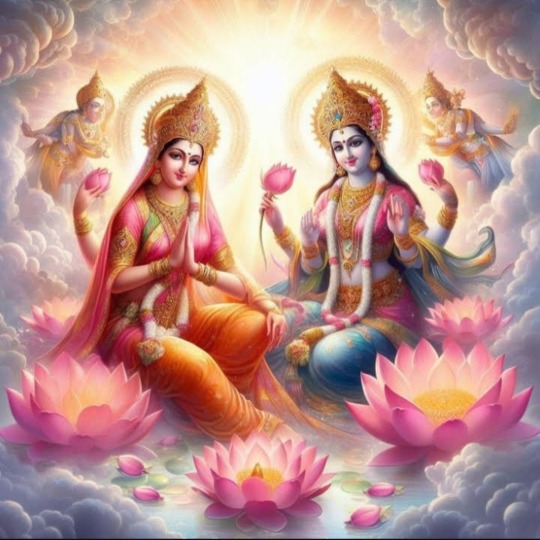
I found this on a YouTube suggestion.
Doesn't it look like Maa Lakshmi and Maa Mohini?
@kanhapriya @krishna-premi @krishna-priyatama @saanjh-ki-dulhan @ramayantika @mindless-tirades @janaknandini-singh999 @hinsaa-paramo-dharma @desi-yearning @akshinayak @budugu @suvarnarekha @raven-with-swords
#desiblr#krishna#desi culture#vedic culture#hinduism#gopiblr#hindu#radhakrishna#mohini devi#lakshmi devi#sanatana#sanatana dharma
82 notes
·
View notes
Text
The Yamas and Niyamas are ethical and moral guidelines
The Yamas and Niyamas are ethical and moral guidelines outlined in the ancient yogic philosophy of Patanjali's Yoga Sutras. They offer principles for living a harmonious and fulfilling life. Here are the benefits associated with practicing the Yamas and Niyamas:
Yamas:
Ahimsa (Non-violence): Practicing ahimsa promotes peace and compassion. It encourages individuals to cultivate kindness towards themselves and others, leading to improved relationships and a more harmonious society.
Satya (Truthfulness): Living truthfully fosters authenticity and integrity. Being honest with oneself and others builds trust and strengthens connections, resulting in healthier relationships and a sense of inner peace.
Asteya (Non-stealing): By practicing asteya, individuals learn contentment and gratitude for what they have. This cultivates a mindset of abundance rather than scarcity, promoting generosity and reducing feelings of envy or lack.
Brahmacharya (Moderation): Brahmacharya encourages balanced living and mindful consumption. By practicing moderation in all aspects of life, individuals conserve energy, maintain focus, and cultivate self-discipline, leading to greater physical, mental, and emotional well-being.
Aparigraha (Non-attachment): Aparigraha teaches the art of letting go and releasing attachments to outcomes. By detaching from material possessions, expectations, and desires, individuals experience freedom from stress, anxiety, and dissatisfaction, leading to greater contentment and inner peace.
Niyamas:
Saucha (Purity/Cleanliness): Practicing saucha involves purifying the body, mind, and environment. This fosters clarity of thought, enhances physical health, and creates a conducive space for spiritual growth and self-discovery.
Santosha (Contentment): Santosha promotes gratitude and acceptance of the present moment. Cultivating contentment regardless of external circumstances leads to greater peace of mind, reduced stress, and an increased sense of fulfillment.
Tapas (Discipline): Tapas involves cultivating self-discipline and perseverance in pursuit of spiritual growth and personal development. By embracing challenges and overcoming obstacles, individuals build resilience, inner strength, and a sense of accomplishment.
Svadhyaya (Self-study): Svadhyaya encourages self-reflection and introspection. By studying sacred texts, exploring personal beliefs, and observing one's thoughts and actions, individuals gain insight into themselves, deepen their understanding of life's mysteries, and foster spiritual evolution.
Ishvara Pranidhana (Surrender to the Divine): Ishvara Pranidhana involves surrendering to a higher power or divine intelligence. By relinquishing the ego's need for control and trusting in a greater purpose, individuals find peace, guidance, and spiritual connection.
Overall, practicing the Yamas and Niyamas promotes personal growth, ethical behavior, and spiritual development. By aligning one's actions with these principles, individuals cultivate virtues such as compassion, truthfulness, contentment, and self-discipline, leading to a more fulfilling and meaningful life.
#astrology numerology vedicastrology#vedic astrology#vedas#vedic jyotish online#astrology#vedic astro observations#lordkrishna#krishna#harekrishna#hare krishna#vedic culture#veda#vedanta
28 notes
·
View notes
Text

Ancient Vedic Temples ॐ Varaha Rupam sculpture of Maha Vishnu in Hassan District by Hoysala architects.
#Vishnu#hare krishna#iskcon#krishna#bhakti#vedic#srila prabhupada#bhagavad gita#Hinduism#Vedic Culture#Ancient Hindu Temples#Varaha Avatar
7 notes
·
View notes